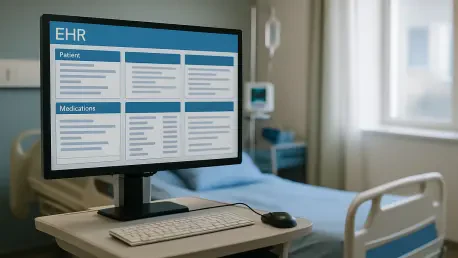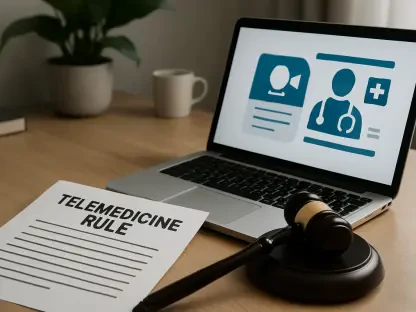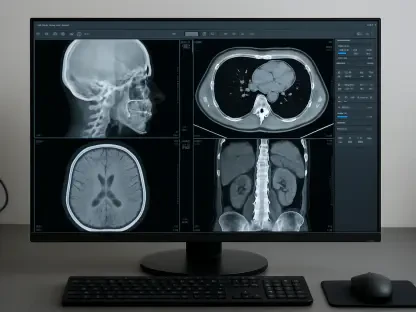In the demanding landscape of modern healthcare, clinicians face an escalating challenge with Electronic Health Records (EHRs), a system designed to enhance documentation and data sharing but often resulting in significant time constraints, particularly during new patient visits. This administrative burden frequently extends work hours, pushing providers to complete tasks outside scheduled times, which contributes to widespread burnout and diminished job satisfaction. The ripple effect of this issue touches patients as well, with rushed interactions leaving them feeling overlooked or undervalued, ultimately straining the provider-patient relationship. A recent study in the Journal of General Internal Medicine sheds light on how streamlining these visits can alleviate the pressure of EHR documentation, offering a pathway to improved care quality and clinician well-being. By addressing the inefficiencies tied to extensive record-keeping, healthcare systems stand to gain not only in terms of provider morale but also in fostering stronger patient connections. This exploration into reducing EHR burdens through optimized patient encounters reveals promising strategies that could reshape the healthcare experience for all stakeholders involved.
Understanding the EHR Burden
Challenges of EHR Documentation
The relentless demand of EHR documentation poses a substantial obstacle for healthcare providers, especially during new patient visits where comprehensive records must be established from scratch. Many clinicians find themselves spending excessive time entering data, often extending their workday well beyond regular hours to keep up with administrative tasks. This phenomenon, often termed “after-hours” EHR management, places a heavy toll on providers, leading to heightened stress levels and a pervasive sense of dissatisfaction with their roles. The constant pressure to balance clinical duties with digital paperwork chips away at the time available for personal recovery, amplifying the risk of burnout across the profession. As this cycle persists, it becomes clear that the current approach to EHR usage is unsustainable without targeted interventions to lighten the load.
Beyond the personal impact on clinicians, the burden of EHR documentation significantly alters the dynamics of patient interactions in a way that undermines care quality. When providers are forced to prioritize data entry over meaningful dialogue, appointments often feel hurried, leaving patients with the impression that their concerns are not fully addressed. This rushed environment directly correlates with lower satisfaction rates, as individuals seek not just medical expertise but also empathy and understanding from their healthcare team. The tension between administrative demands and the need for genuine engagement creates a challenging scenario where the human element of medicine risks being overshadowed by technology. Addressing this disconnect is essential to restoring trust and ensuring that patient needs remain at the forefront of every encounter.
Impact on Care Delivery
The strain of EHR-related tasks also reverberates through the broader framework of care delivery, disrupting the efficiency of healthcare settings. When new patient visits are prolonged by the need for detailed documentation, appointment schedules become congested, often delaying access to care for others in need. This backlog not only frustrates patients awaiting their turn but also adds pressure on clinicians to speed through interactions, further eroding the quality of engagement. The cascading effect of these delays can compromise the overall patient experience, as individuals may perceive the system as unresponsive to their urgent needs. Finding ways to streamline these processes is critical to maintaining a balance between thorough record-keeping and timely service provision.
Moreover, the focus on EHR completion during visits can detract from the diagnostic and therapeutic aspects of medical practice, which are central to effective healthcare. Providers, preoccupied with ensuring every detail is logged correctly, may inadvertently miss subtle cues or patient concerns that are vital for accurate assessments. This diversion of attention from clinical priorities to administrative necessities risks diminishing the standard of care, potentially leading to oversights that could affect health outcomes. A shift toward minimizing the time spent on digital tasks during face-to-face interactions is necessary to refocus efforts on what truly matters—delivering attentive and personalized medical support to each patient.
Strategies for Streamlining Patient Visits
Innovative Solutions
One promising avenue for reducing the EHR burden lies in the integration of advanced clinical decision support systems, which offer real-time, context-sensitive assistance to providers during patient encounters. These tools can significantly cut down on manual data entry by auto-populating relevant fields with standardized information or suggesting documentation based on the context of the visit. By simplifying the process of recording patient histories and treatment plans, such systems allow clinicians to maintain focus on the individual in front of them rather than on a screen. The efficiency gained through this technology not only shortens the duration of new patient visits but also enhances the accuracy of records by reducing human error. As healthcare facilities explore adopting these solutions, the potential to transform routine documentation into a seamless task becomes increasingly tangible.
Another critical strategy involves the adoption of team-based care models, which distribute EHR-related responsibilities across a wider group of healthcare professionals, including nurses and administrative staff. By delegating non-clinical tasks such as data input or preliminary record updates to team members, physicians are freed up to concentrate on direct patient care and complex decision-making. This collaborative approach not only lightens the administrative load on individual providers but also fosters a more cohesive working environment where each role contributes to the patient’s journey. The redistribution of tasks ensures that no single person bears the brunt of documentation demands, paving the way for more balanced workloads. Implementing such models requires careful coordination, but the payoff in terms of reduced stress and improved care delivery makes it a compelling option for many facilities.
Systemic Reforms
Beyond specific tools and team structures, systemic reforms are essential to address the root causes of EHR burdens in healthcare settings. A key focus is on redesigning workflows to prioritize efficiency without compromising the depth of patient records, ensuring that documentation requirements are practical and aligned with clinical needs. Industry dialogue continues to emphasize the importance of tailoring EHR systems to minimize redundant or overly complex data entry fields that consume unnecessary time. By streamlining these digital interfaces, providers can complete necessary tasks more swiftly, leaving room for meaningful patient engagement. Such changes demand collaboration between software developers, healthcare administrators, and frontline staff to ensure that updates genuinely serve the end users.
Additionally, ongoing training and support for EHR usage play a vital role in easing the transition to streamlined processes, helping clinicians adapt to new tools and protocols with confidence. Educational initiatives that focus on best practices for documentation can prevent the common pitfalls of over-recording or inefficient navigation of EHR platforms. Pairing this with continuous feedback mechanisms allows healthcare systems to identify persistent pain points and refine their approaches accordingly. The commitment to evolving EHR management through systemic adjustments reflects a broader recognition that technology should support, not hinder, the mission of healthcare. As these reforms take shape, they hold the promise of creating an environment where administrative tasks no longer overshadow the core purpose of medical practice.
Broader Implications of Streamlined Visits
Benefits for Stakeholders
Reducing the time spent on EHR documentation offers substantial benefits for clinician well-being, addressing one of the most pressing issues in healthcare today. When administrative burdens are lightened through streamlined visits, providers gain more control over their schedules, allowing for a healthier balance between professional and personal life. This shift can lead to lower stress levels, decreased burnout rates, and ultimately higher job retention, which is crucial amid ongoing staffing shortages. The mental and emotional relief that comes from spending less time on after-hours tasks also enables clinicians to approach each day with renewed focus and energy. As a result, healthcare organizations stand to benefit from a more motivated and stable workforce, ready to tackle the challenges of patient care.
Equally important is the positive impact on the patient experience, where shorter, more focused visits can strengthen trust and satisfaction with providers. When clinicians are not bogged down by excessive documentation, they can dedicate more attention to listening and addressing individual concerns, creating a sense of being truly heard. This deeper connection fosters a therapeutic alliance, which is fundamental to effective treatment and long-term health outcomes. Patients who feel valued during their interactions are more likely to adhere to medical advice and return for follow-up care, enhancing continuity. Streamlining visits thus serves as a bridge to rebuild the human element of medicine, ensuring that technology enhances rather than detracts from personal engagement.
Enhancing Healthcare Systems
The efficiency gained from streamlined patient visits also translates into broader advantages for healthcare systems grappling with rising service demands. By cutting down on the time spent per encounter without sacrificing care quality, facilities can accommodate more patients within the same operational framework, reducing wait times and improving access. This scalability is particularly vital in an era where population growth and aging demographics continue to strain resources. Optimized workflows mean that clinics and hospitals can manage higher volumes while maintaining standards, a balance that is essential for sustainability. Such improvements position healthcare systems to respond more effectively to community needs, ensuring that no one is left behind due to logistical bottlenecks.
Looking ahead, the adoption of streamlined processes signals a proactive step toward future-proofing healthcare delivery against evolving challenges. As technology and care models continue to advance, the lessons learned from reducing EHR burdens can inform other areas of operational reform, from appointment scheduling to resource allocation. The emphasis on teamwork and digital tools sets a precedent for innovation, encouraging facilities to experiment with tailored solutions that fit their unique contexts. Reflecting on past efforts, the journey to balance administrative efficiency with patient-centered care has shown that intentional change yields measurable benefits. Stakeholders who embraced these strategies witnessed enhanced morale among staff and greater trust from patients, underscoring the value of sustained commitment to improvement.









